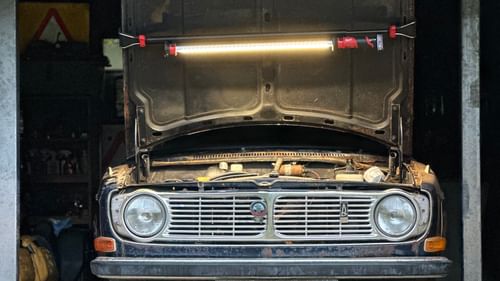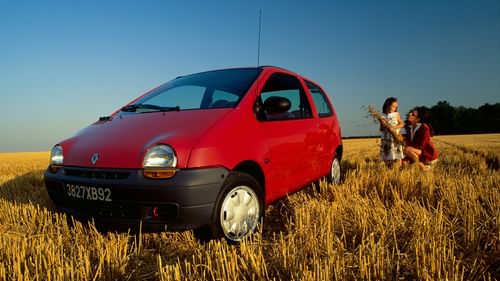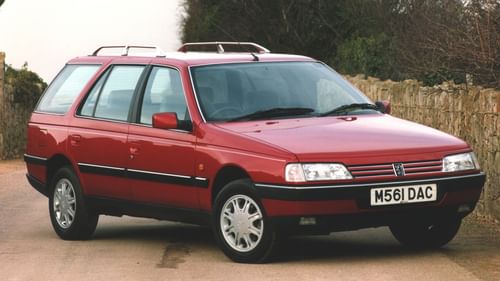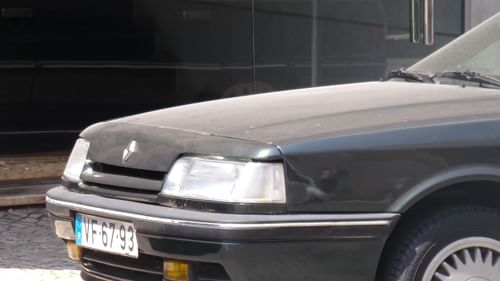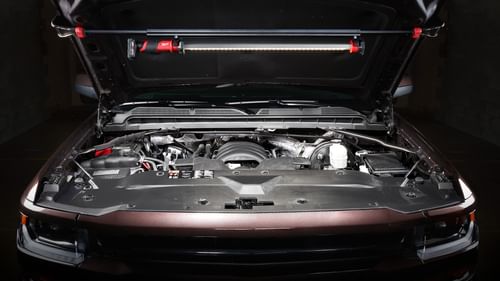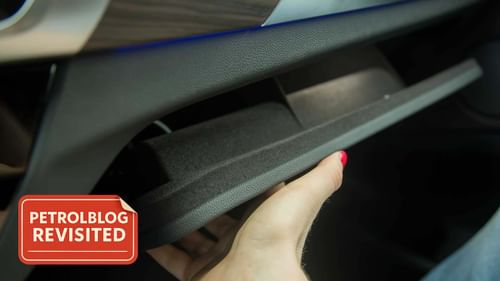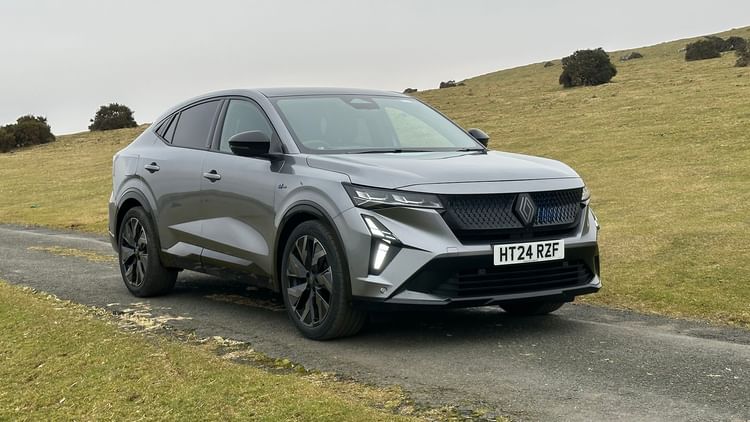
In a break from tradition, Petrolblog is doing a long-term review of a new car. A proper test like the big name titles, albeit on the pages of Petrolblog and not a proper motoring website. Still, on paper at least, the Renault Rafale E-Tech hybrid is a Petrolbloggy new car.
Note: These updates are in reverse order, because that’s how the internet works. So if you want to read about the Rafale’s presidential ambitions before its eco warrior phase, you’re in the right place. Scroll down if you’d rather start from the top… which is actually the bottom. You get the idea.
Final update (September 2025): 15,000 miles, 7 months and one tractor impersonation later
I didn’t expect to still have the Rafale as the mornings turned cold and the nights grew long. But here we are: season of mists, mellow fruitfulness and touchscreen faffing.
The colder weather gave me a chance to explore some of the car’s many gadgets. Take the heated steering wheel: a luxurious thing in theory, but in practice, it requires multiple stabs at the touchscreen to get it working. It’s strangely uncooperative, like a French waiter deciding whether or not to acknowledge your order. A minor annoyance, but more ammo for the ‘just give me a button’ brigade.
The Rafale’s LED matrix headlights are more reliable, and they put on a little Jean-Michel Jarre light show every time you unlock the car. Very impressive, unless you’re trying to make a stealthy 5am getaway without waking the dogs. Still, the beam itself is excellent: no flashing from oncoming traffic, no angry hand gestures, no moments of doubt.
My favourite bit of the system, though – and I know this is niche – is the stalk button. There’s a little soft-touch circle at the end of the left-hand stalk for switching between auto and manual high-beam. It’s perfectly placed and beautifully damped; the kind of detail that tells you someone, somewhere, still cares about tactility. I used it constantly. If I’d had the car any longer, I might have made a badge.
Less satisfying: the wind noise from the driver’s door. I’m starting to suspect it’s following the passenger side’s lead and slowly drooping on its hinges, possibly in solidarity. Or maybe I’m imagining it.
Then there’s the cold-start soundtrack. On battery alone, the Rafale is serene. But when it wakes the engine to charge the traction battery, it sounds like a Massey Ferguson with indigestion. A few days ago, I reversed silently off the driveway, only for the generator to kick in and ruin the dawn chorus. Later that day, my mum asked, “What’s that noise – is it coming from that skip lorry?” She refused to believe it was the Rafale. I didn’t push it.
And just like that, it’s gone. The car was collected the same afternoon I filed this report, which felt oddly abrupt. No final blast down the Fosse Way. No moody last photo in a lay-by. Just a keycard handed over and a space left behind. Probably a fitting exit for a car that never chased the spotlight.
So, what sticks in the memory? Quite a lot, actually. The road trip to France and Spain, trying (and failing) to get from Istres to Palencia on one tank, remains a standout. And while it was occasionally glitchy – hello, random alarm and Apple CarPlay tantrums – the Rafale was smooth, calm, and impressively frugal.
I’ll miss the way it glided about in EV mode. I’ll miss the exclusivity. I’ll miss that stalk button.
The Rafale isn’t perfect, and I suspect it’ll stay rare in the UK. It might well follow the Safrane, Avantime and Vel Satis into Renault’s ‘interesting but under-appreciated’ file. I still think a big French saloon or estate is the better choice. But I’ve developed a real soft spot for the Rafale.
If I see another one out in the wild (and I’m not holding my breath), I’ll give it a presidential-style salute. Quietly. Respectfully. Possibly while fiddling with a stalk button that still feels better than it has any right to.

August 2025 – 14,891 miles
If you run a small fleet of neglected, unloved old cars (as I do), then you’ll know the fight isn’t always with rust or dodgy electrics – it’s with mice. Warm gloveboxes, fluffy bonnet insulation and the boot of anything parked under a tree become luxury mouse real estate. Catch them early, and it’s just chewed trim and eau de rodent. Leave them, and you’ll be phoning a classic insurance broker asking if chewed wiring counts as an act of God.
Thankfully, the Rafale remains mouse-free. It’s used far too regularly to become vermin B&B. But while the wildlife has stayed away, I’m starting to wonder if its own electrical gremlins are moving in.
Nothing major, but at just shy of 15,000 miles, a few glitches have crept in; the kind that never show up on a 30-minute test drive but make themselves known just as the car’s warranty paperwork starts getting coffee stains.
The most antisocial issue? The alarm. It has developed a taste for drama, occasionally going off for no reason –including several times in a remote Spanish mountain village in the Picos de Europa, which really upped the ‘awkward tourist’ factor. It's also done it back home, in car parks, on driveways, and basically anywhere silence is preferred. A quick online nosy suggests this isn’t unique to my car – a few Austral and Rafale owners report the same. So it’s probably time for another trip to the dealer. While it’s there, I’ll ask them to take a look at the passenger door, which now droops so badly it’s occasionally left ajar. Silver lining: if it’s not shut properly, at least the alarm doesn’t go off...
Then there’s the audio gremlin. Sometimes, when I start the car, all sound from Apple CarPlay – music, podcasts, directions – comes out of my phone instead of the speakers, as though the Rafale’s just not in the mood. On other occasions, the touchscreen freezes or looks like it’s streaming from a potato – full pixelation, early-2000s YouTube vibes. Again, not a disaster, just weird – and oddly disappointing in a car that otherwise feels so upmarket and tech-savvy.
On the plus side, the 1.2-litre engine continues to bed in beautifully. It now feels perkier, especially when joining motorways or climbing hills. It’s still not quick, but it no longer feels apologetic. At the same time, the tyres are showing signs of wear – something I’ve noticed more in low-speed, tight turns where there’s a bit of slip from the front wheels. That might be down to the four-wheel steering, which remains a godsend in car parks but could be giving the tyres extra work. Maybe I’ll budget for a full set before the presidential Rafale needs a new set of Michelins.
And finally, a landmark moment: I saw another Rafale! It was finished in Summit Blue (a cracking shade), and the look of mutual surprise exchanged in the pub car park felt like a Renault-spec secret handshake. There are few of us out there – but we know who we are.
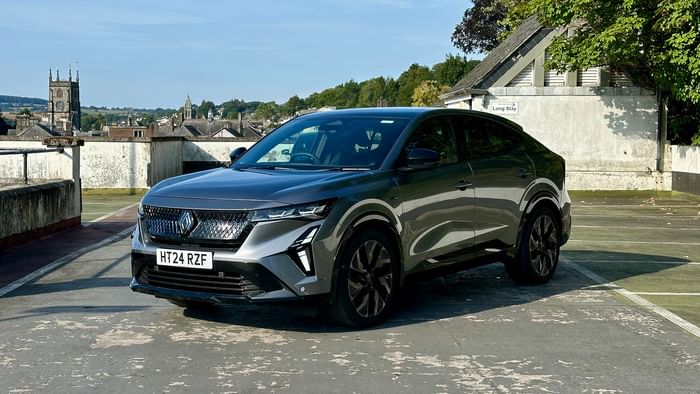
July 2025 – 12,703 miles
It’s not every day you find yourself driving the same car as a head of state. But in July, Renault unveiled a presidential version of the Rafale – and suddenly my long-termer had the full République stamp of approval. Bleu Présidence paint, armoured body, flag mounts, the works. All very appropriate for a president keen to fly the tricolour for hybrid power and homegrown industry.
But while Emmanuel Macron’s chauffeur-driven Rafale looks the part sweeping up to the Élysée, it did get me wondering how the same car performs in more everyday scenarios. Such as: can it carry two Labrador crosses, a bag of sticks and the lingering damp of the Devon countryside?
Answer: not easily.
On paper, the Rafale’s 535-litre boot sounds respectable, and the powered tailgate certainly feels presidential. But the sloping roofline chips away at rear headroom and the boot lip is both high and awkward – perfect for showy luggage on a Parisian boulevard, less so for lifting 30kg of dog who’d really rather stay on the ground, thanks. The drop from bumper to boot floor is significant enough that one of ours flat-out refuses to jump in. In fairness, I wasn’t keen on lifting him either. It’s not that the Rafale is impractical per se, just that it’s not dog practical.
There’s a small but persistent irritation with the boot, too: open it after rain and prepare for an impromptu cold shower. Water channels off both sides and lands on your head with unnerving accuracy. Fine if you’ve got presidential bodyguards holding umbrellas; less fine if you’re loading a weekly shop in soggy Devon.
More worryingly, a quality niggle has started to creep in. The passenger door seems to have dropped slightly on its hinges, catching as it opens and closes. It’s not a catastrophe, but it is the sort of thing that shouldn’t really be happening on a flagship Renault with aspirations of taking on Audi and BMW. If you want people to believe the Rafale is a genuine premium contender, the fundamentals – like doors – need to behave like they belong on a £40k+ SUV.
Still, there’s a lot that continues to impress. The hybrid system seems to get better with age, leaning more heavily on EV mode with every mile and delivering quiet, fuss-free progress in a way that makes plug-ins feel like hard work. It also still turns heads – presumably because not many people know what it is. In that sense, it’s not unlike the Safrane: an under-appreciated big Renault that always flew under the radar.
Only now it’s presidential.

May 2025 – 7,520 miles
We need to talk about speed limits. Or, more specifically, how the Rafale chooses to interpret them. Which is to say: creatively. On a recent drive through the west London suburbs, it confidently insisted I could do 80mph in a 20mph zone. Bold. Elsewhere, it flicks between 50 and 60mph on motorways like it’s tuning into Radio 2. It also treats those homemade 20mph signs you find in villages – the ones drawn with a Sharpie on a bit of plywood – as gospel truth.
This matters because of Intelligent Speed Assistance (ISA), a soon-to-be-mandated tech that could one day stop you from exceeding the speed limit whether you like it or not. Right now, the Rafale just gives you a passive-aggressive bong if you go too fast, but you can silence it... until the next time you restart the car, when it comes right back like a digital nagging aunt. It’s not a dealbreaker, just a reminder that ISA has a way to go before we can fully trust our cars to know better than we do.
Elsewhere in Rafale-world, it was time for the big 7,000-mile spa day: its first service at Vertu Renault in Exeter. I booked a ‘while-you-wait’ slot at 8:30am and was told it’d be 90 minutes, maybe two hours. Reader, I left at 1:30pm. Turns out the car was subject to an unexpected recall relating to the Hybrid Electric Vehicle Controller (HEVC), and the workshop had never dealt with it before. Nor had they seen many Rafales – mine was only the third to roll into their lives since launch. For a brief moment it looked like I’d be going home in a courtesy Clio, but thanks to a sharp-eyed master technician, the Rafale was sorted just before lunch.
While I waited (and waited), I got chatting with one of the sales team. Rafale sales, she said, had been a bit slow. Not surprising, perhaps, given the price – especially compared to its cheaper, more practical sibling, the recently refreshed Austral. The Rafale feels more upmarket, granted, but its close resemblance to the Austral could be working against it in the showroom. It’s not hard to imagine the Rafale joining the great line of underrated big Renaults – cars like the Vel Satis, Avantime and, yes, the Safrane – that never quite found a home in the UK. In three months, I’ve seen just two others on the road.
If I were selling it (and I’d be terrible at it), I’d start with the Solarbay panoramic roof. Genuinely clever tech and the one feature everyone comments on. It’s a one-metre square slab of glass that switches between four tint settings: all dark, rear dark, front dark or fully clear. It even remembers your setting when you lock the car. You can change it via a roof-mounted button or just ask Google, and it’s standard on this Iconic Esprit Alpine version. Ferrari charges north of £13,000 for a similar feature on the Purosangue. Here? It’s included.
Even the lad who washed and vacuumed the car at Vertu was impressed: “That roof’s actually well cool.” He’s not wrong.
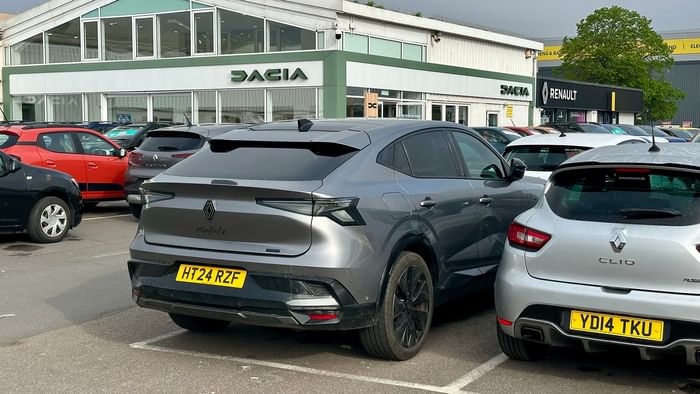
April 2025 – 5,917 miles
Well, that didn’t last long. My brief but glorious stint as a hypermiling eco evangelist came to an abrupt end in mid-March, following a life-affirming encounter with the Fosse Way and the Rafale’s Sport mode. One moment I was coasting in EV silence like a budget Elon Musk, the next I was carving through middle England pretending I was Jean Ragnotti in a Gant hoodie.
The decline began with a trip to Lincolnshire. The outward leg was predictably frugal – all efficient routing and fuel-saving smugness. But the thought of another M69–M6–M42–M5 soul-drainer on the way home filled me with dread. So I asked Google to plot a motorway-free route back to Devon. It must have dusted off its schoolbook map of Roman Britain, because I was promptly directed down the Fosse Way – and what a decision that was. No, it’s not Route 66 or the Stelvio Pass, but Enderby to Stow-on-the-Wold gave me one of the most unexpectedly joyful drives I’ve had in years.
Stick the Rafale in Sport mode, and it transforms, not into a Renault Sport product (steady on), but into something surprisingly playful. The mood lighting turns red (ooh, drama), the throttle sharpens up, body control tightens and the four-wheel steering pivots from stability to agility. It’s subtle, but enough to make the car feel lighter and more awake.
More importantly, Sport mode eliminates the occasional ‘what power do I need?’ hesitation when you ask for full beans. It doesn’t exactly become a B-road hooligan, but it does shed its sensible hybrid image for something… spirited. All that’s missing is a manual gearbox – which, of course, will never happen, but still.
Eventually, I peeled off at Stow and rejoined the M5 for my customary pit stop at Gloucester Services (still the Waitrose of motorway hospitality). What’s curious is that despite the enthusiastic detour, fuel economy has barely suffered – I’m nudging 50mpg now. Still short of Renault’s lofty 60.1mpg claim, but for a 1.2-litre, three-cylinder SUV lugging around a battery, motors, four-wheel steering and a Harman Kardon sound system designed by Jean-Michel Jarre, I’ll take it.
That’s the joy of hybrids, isn’t it? You get the quiet bits, the clever bits, the cheap-to-run bits – without needing a wallbox and an Excel spreadsheet to plan your life.
I do, however, have a small bone to pick with Monsieur Jarre’s contribution. The Rafale’s pedestrian warning system – which plays an electronic melody at low speeds – is meant to alert the unsuspecting to your EV-mode approach. And yet, so far, it’s taken out two game birds on Devon lanes and given one poor shopper a fright in a Waitrose car park. Either the birds aren’t fans of synth music, or the warning tune is less "Oxygène" and more ‘barely perceptible whoosh.’ I may have to switch from Jarre Classic to Expressive Mode and see if the local wildlife fare any better.
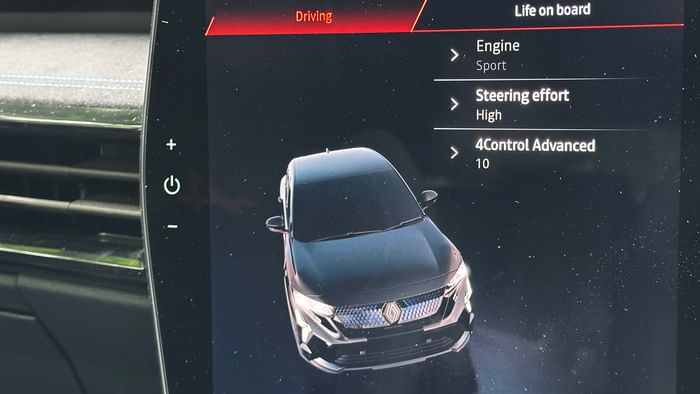
March 2025 – 3,867 miles
When a certain weekly car mag described the Renault Rafale as a “new-age Safrane,” I felt a small ripple of joy. As someone who owns two Safranes (neither of which currently boasts an MOT, but let’s not dwell on technicalities), the chance to run the Rafale for six months felt like fate – or at least a very kind nod from the editor of Diesel&EcoCar. The plan is to have both old warhorses roadworthy before the Rafale returns to Renault HQ in August. I say ‘plan’ with the weary optimism of someone who knows what owning 1990s French metal really involves.
So here we are: one month in, with 1,500 mostly motorway miles logged in Renault’s latest hybrid SUV. The Rafale hasn’t come to Devon for a rural sabbatical. No, it’s working for a living. This one’s the regular hybrid: a 1.2-litre, three-cylinder petrol engine teamed up with a duo of electric motors. One helps out with propulsion, the other acts as a starter-generator-slash-wizard. Together they muster 197bhp, get from 0–62mph in 8.9 seconds, and top out at a sensible 111mph.
Nothing earth-shattering, you might think, until you look at the numbers that really matter: 60.1mpg, 105g/km CO2, and a claimed 683 miles between fill-ups. That’s diesel-rivalling range without diesel prices – and all while avoiding the guilt of sullying the local air. The Rafale loves EV mode and isn’t shy about flaunting it. Even at brisk motorway speeds (yes, including the ‘plus 10 percent’ bit), the car often glides silently, blue EV indicator glowing proudly in the corner of the 12.3-inch digital cluster.
It’s turning me into a better, greener driver. My eco score has climbed from a modest 75 percent to a smug 90+ percent on most journeys. Somewhere, the spirit of the Energy Saving Trust is applauding.
This being the Iconic Esprit Alpine version, it comes loaded with more kit than your average mid-size premium SUV – and costs just over £40k, meaning it crosses the threshold into expensive-car VED territory. Still, you get 20-inch alloys, Alcantara/fabric seats complete with backlit Alpine logos (no, really), a 9.3-inch head-up display, heated everything (including seats, steering wheel and windscreen), four-wheel steering, ambient lighting, a Harman Kardon system co-developed by none other than Jean-Michel Jarre, and a panoramic sunroof called Solarbay with four levels of opacification. It’s all a bit Tomorrow’s World, and I adore it – although I already fear for its longevity. My Safranes are teaching me to think in decades, not warranties.
There’s even a giant puddle light logo big enough to make a Renault Magnum blush. Whether that’s cool or cringe depends on how much irony you have left in your tank.
Yes, it shares DNA with the Renault Austral, but the Rafale feels like more than a rebodied sibling. Where the Austral left me cold, the Rafale feels right. Comfortable, refined, and just interesting enough to keep the long journeys engaging. After a 500-mile round trip to Epping Forest, I honestly felt like I could have carried on to Land’s End – or across the Atlantic, if someone could kindly build a bridge. With my new-found eco skills, I might have even made it on one tank.
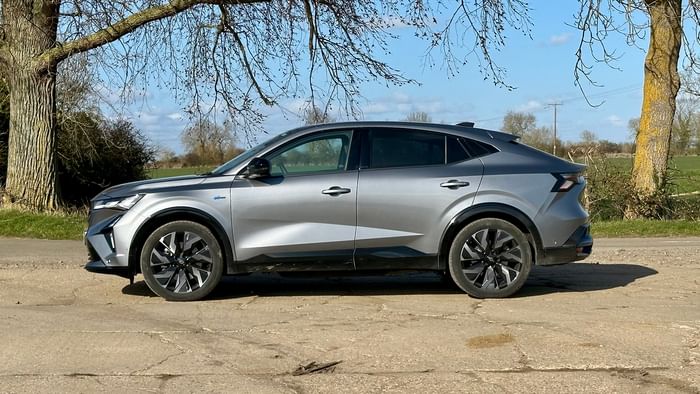
Original post: The Rafale is surprisingly Petrolbloggy
Why? Well, for a start it's French, which makes it more interesting than most German cars. Secondly, it's been labelled a ‘new-age Safrane’ by none other than Autocar magazine. A Safrane E-Tech would be a marvellous thing, but for now let's focus on Renault's flagship SUV.
The Rafale is one of seven Renault SUVs and is available as either a hybrid or a plug-in hybrid. Petrolblog's test car is the more affordable hybrid, which pairs a 1.2-litre three-cylinder petrol engine with a couple of electric motors to produce a total of 197bhp.
There are also three trim levels: Techno, Techno Esprit Alpine and Iconic Esprit Alpine. Petrolblog has been treated to the top trim, which costs £44,695, although with optional Shadow Grey metallic paint, the price increases to £45,945 – the equivalent of 45 Renault Safranes.
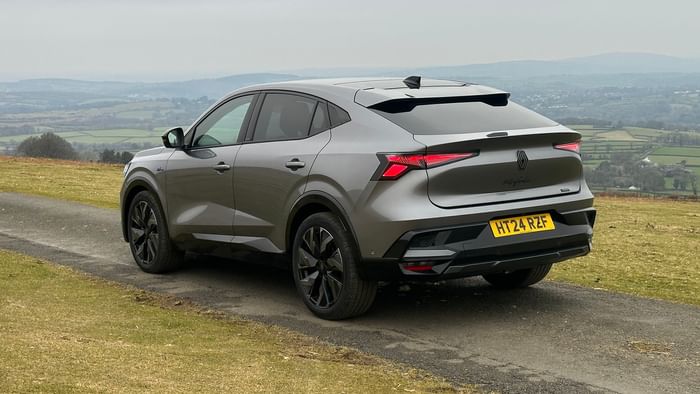
To say it's fully loaded would be an understatement; it'd be easier to list what it doesn't have. For the purposes of this introduction, the highlights are: dual-zone climate control, electric tailgate, heated windscreen and steering wheel, heated front seats, panoramic sunroof, 20-inch diamond-cut alloy wheels, interior ambient lighting, Alcantara upholstery, four-wheel steering, keyless entry and start, wireless phone charger, front and rear parking sensors, 3D camera, hands-free parking, a suite of driver assistance systems and a cuddly toy.
Did you get all that? Bruce Forsyth and Larry Grayson will be along in a moment to test your skills of recollection. You can't ask Isla St Clair for help.
As for the onboard tech, you get a 12.3-inch digital instrument panel, a 9.3-inch head-up display, 12-inch touchscreen infotainment system, 12-speaker Harman Kardon audio system, built-in Google and, get this, soundscapes developed in collaboration with Jean-Michel Jarre. Yes, really.
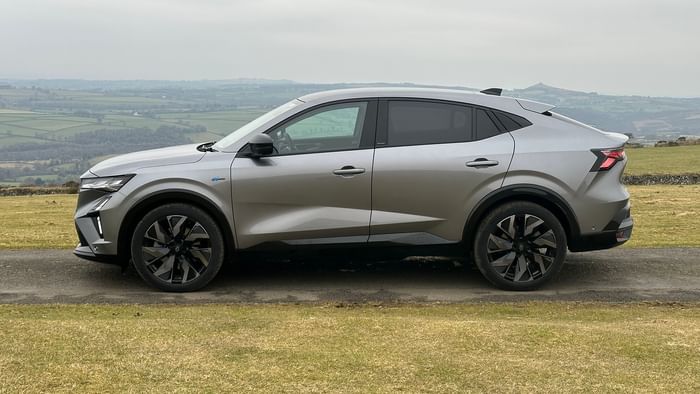
First impressions are good, not least because everything works – quite a novelty when you own a fleet of (mostly terrible) French cars. Does it look like a Renault? Arguably not; cover the badges and a lot people would require a few guesses before saying it's French, let alone a Renault.
That's not a criticism; Renault is one of the more interesting car companies of 2025, with retro-inspired electric cars like the 5 E-Tech and 4 E-Tech on the one hand, and impressive SUVs like the Megane E-Tech and Scenic E-Tech on the other.
You suspect that Renault is targeting Audi, BMW and Mercedes buyers with the Rafale, so it'll be interesting if it can pull off the whole ‘Unmistakeably German (Made in France)’ thing with the coupé-SUV. Actually, it can't, because the Rafale is built in Spain.
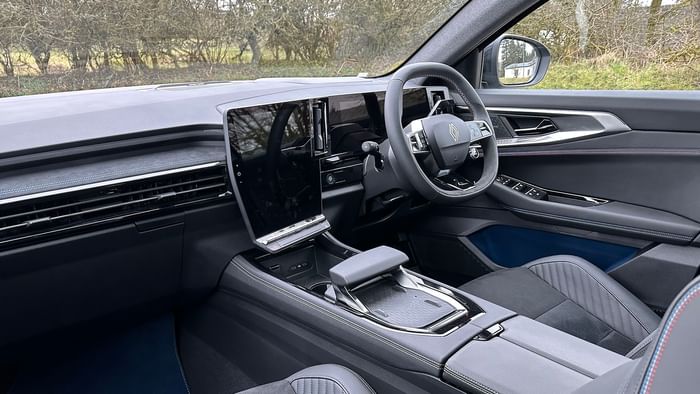
Petrolblog will be running the Renault Rafale for Diesel&EcoCar magazine until the middle of August, so get in touch if you have any questions or would like any specific information on the car. A twin test with one of the Renault Safranes will happen if at least one person requests it...
Stay tuned for the first update. In the meantime, here are some quick reviews from the proper websites, along with the price, performance and economy figures.
- Autocar: Segment-bending flagship is plush, well-equipped and best-served in plug-in hybrid form – 3.5 (out of 5)
- Auto Express: The new Renault Rafale is a coupé-SUV Renault can be proud of, and a much better showing in this niche, but very in vogue, segment than the lacklustre Renault Arkana – 3.5 (out of 5)
- Car Buyer: The Renault Rafale is a stylish and practical coupé SUV, but it's not the last word in premium feel – 3.9 (out of 5)
- Heycar: The Renault Rafale is quite a signal of intent for the French company, as a flagship model with complicated hybrid technology and a top-notch interior – 8 (out of 10)
- Honest John: This is Renault's pitch at the premium end of the family SUV segment and is priced accordingly – 4 (out of 5)
- Parkers: Handles tidily, but not much fun – 3.3 (out of 5)
- Top Gear: Renault offers an X4 rival at X2 prices and gets a lot of it right, but arguably misses the point of what a family SUV should really do – 7 (out of 10)
- What Car?: The Rafale has a plush and spacious interior but some rival family SUVs ride and handle better – 3 (out of 5)
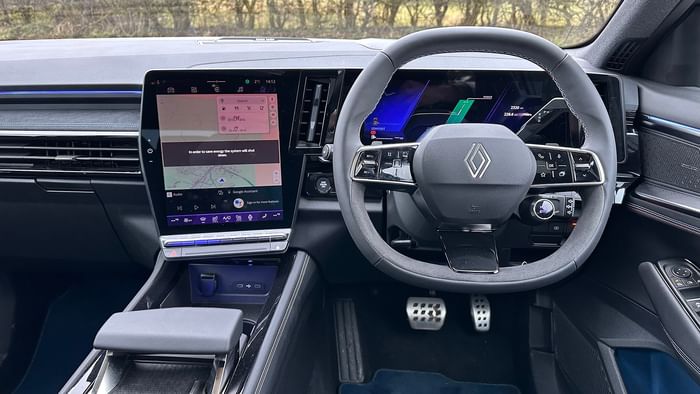
Renault Rafale E-Tech hybrid Iconic Esprit Alpine specification
Price: £44,695
Price as tested: £45,945
Options: Shadow Grey metallic paint £1250
Engine: 1197cc 3-cylinder turbo, petrol, plus two electric motors
Battery: 1.7kWh
Transmission: 5-speed automatic
Max power: 197bhp
Max torque: 205Nm
Max speed: 111mph
0-62mph: 8.9sec
WLTP range: 683 miles
CO2: 105g/km
Fuel economy: 565mpg
BIK: 26%
Insurance group: 30E
Updated September 2025:
The Rafale finished with around 16,000 miles under its belt and a few gremlins under the bonnet. Scroll up for the latest, or scroll down if you’re reading in reverse. Which you are.
